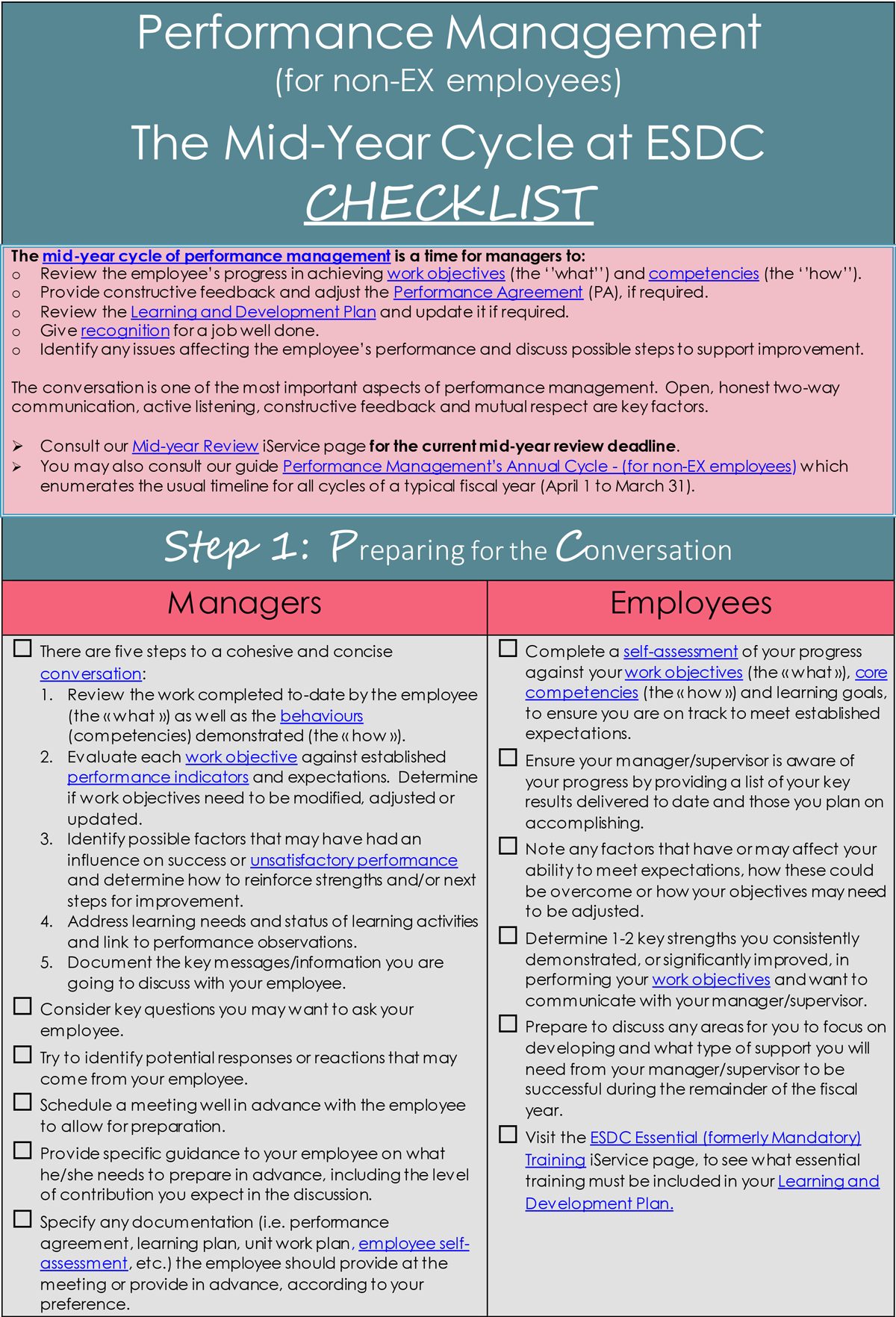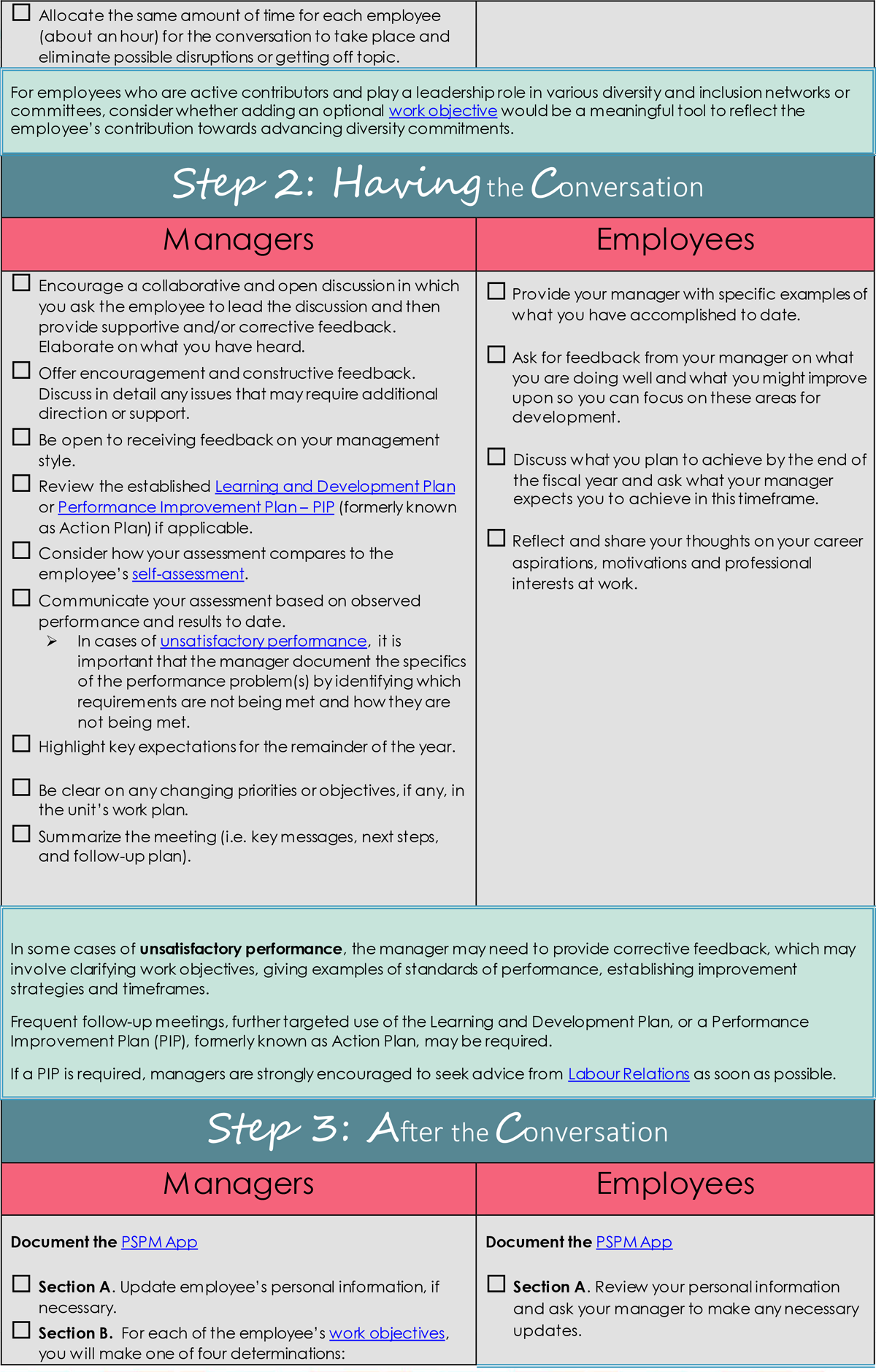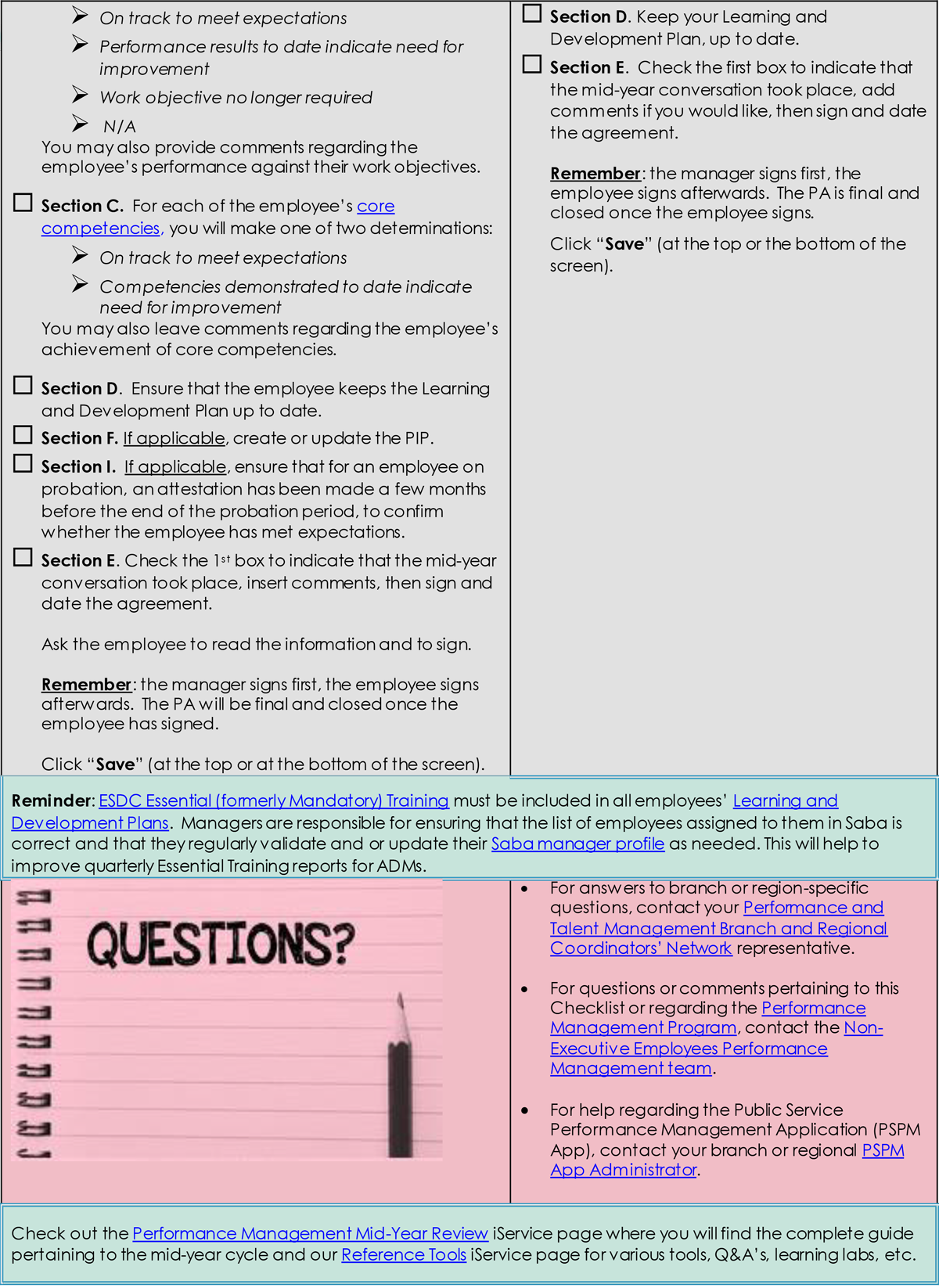Performance Management (for non-EX employees)
The Mid-Year Cycle at ESDC Checklist
The Mid-Year Cycle at ESDC Checklist
Long Description
Performance Management (for non-EX employees)
The Mid-Year Cycle at ESDC Checklist
The mid-year cycle of performance management is a time for is a time for managers to:
- Review the employee’s progress in achieving work objectives (the ‘’what’’) and competencies (the ‘’how’’).
- Provide constructive feedback and adjust the Performance Agreement (PA), if required.
- Review the Learning and Development Plan and update it if required.
- Give recognition for a job well done.
- Identify any issues affecting the employee’s performance and discuss possible steps to support improvement.
The conversation is one of the most important aspects of performance management. Open, honest two-way communication, active listening, constructive feedback and mutual respect are key factors.
- Consult our Mid-year Review iService page for the current mid-year review deadline.
- You may also consult our guide Performance Management’s Annual Cycle - (for non-EX employees) which enumerates the usual timeline for all cycles of a typical fiscal year (April 1 to March 31).
Step 1: Preparing for the Conversation
Managers
- There are five steps to a cohesive and concise conversation:
- Review the work completed to-date by the employee (the « what ») as well as the behaviours (competencies) demonstrated (the « how »).
- Evaluate each work objective against established performance indicators and expectations. Determine if work objectives need to be modified, adjusted or updated.
- Identify possible factors that may have had an influence on success or unsatisfactory performance and determine how to reinforce strengths and/or next steps for improvement.
- Address learning needs and status of learning activities and link to performance observations.
- Document the key messages/information you are going to discuss with your employee.
- Consider key questions you may want to ask your employee.
- Try to identify potential responses or reactions that may come from your employee.
- Schedule a meeting well in advance with the employee to allow for preparation.
- Provide specific guidance to your employee on what he/she needs to prepare in advance, including the level of contribution you expect in the discussion.
- Specify any documentation (i.e. performance agreement, learning plan, unit work plan, employee self-assessment, etc.) the employee should provide at the meeting or provide in advance, according to your preference.
- Allocate the same amount of time for each employee (about an hour) for the conversation to take place and eliminate possible disruptions or getting off topic.
Employees
- Complete a self-assessment of your progress against your work objectives (the « what »), core competencies (the « how ») and learning goals, to ensure you are on track to meet established expectations.
- Ensure your manager/supervisor is aware of your progress by providing a list of your key results delivered to date and those you plan on accomplishing.
- Note any factors that have or may affect your ability to meet expectations, how these could be overcome or how your objectives may need to be adjusted.
- Determine 1-2 key strengths you consistently demonstrated, or significantly improved, in performing your work objectives and want to communicate with your manager/supervisor.
- Prepare to discuss any areas for you to focus on developing and what type of support you will need from your manager/supervisor to be successful during the remainder of the fiscal year.
- Visit the ESDC Essential (formerly Mandatory) Training iService page, to see what essential training must be included in your Learning and Development Plan.
For employees who are active contributors and play a leadership role in various diversity and inclusion networks or committees, consider whether adding an optional work objective (DOCX, 343 KB) would be a meaningful tool to reflect the employee’s contribution towards advancing diversity commitments.
Step 2: Holding the Conversation
Managers
- Encourage a collaborative and open discussion in which you ask the employee to lead the discussion and then provide supportive and/or corrective feedback. Elaborate on what you have heard.
- Offer encouragement and constructive feedback. Discuss in detail any issues that may require additional direction or support.
- Be open to receiving feedback on your management style.
- Review the established Learning and Development Plan or Performance Improvement Plan - PIP (formerly known as Action Plan) if applicable.
- Consider how your assessment compares to the employee’s self-assessment.
- Communicate your assessment based on observed performance and results to date.
- In cases of unsatisfactory performance, it is important that the manager document the specifics of the performance problem(s) by identifying which requirements are not being met and how they are not being met.
- Highlight key expectations for the remainder of the year.
- Be clear on any changing priorities or objectives, if any, in the unit’s work plan.
- Summarize the meeting (i.e. key messages, next steps, and follow-up plan).
Employees
- Provide your manager with specific examples of what you have accomplished to date.
- Ask for feedback from your manager on what you are doing well and what you might improve upon so you can focus on these areas for development.
- Discuss what you plan to achieve by the end of the fiscal year and ask what your manager expects you to achieve in this timeframe.
- Reflect and share your thoughts on your career aspirations, motivations and professional interests at work.
In some cases of unsatisfactory performance, the manager may need to provide corrective feedback, which may involve clarifying work objectives, giving examples of standards of performance, establishing improvement strategies and timeframes.
Frequent follow-up meetings, further targeted use of the Learning and Development Plan, or a Performance Improvement Plan (PIP), formerly known as Action Plan, may be required.
If a PIP is required, managers are strongly encouraged to seek advice from Labour Relations as soon as possible.
Step 3: After the Conversation
Managers
Document the PSPM App
- Section A. Update employee’s personal information, if necessary.
- Section B. For each of the employee’s work objectives, you will make one of four determinations:
- On track to meet expectations
- Performance results to date indicate need for improvement
- Work objective no longer required
- N/A
You may also provide comments regarding the employee’s performance against their work objectives.
- Section C. For each of the employee’s core competencies, you will make one of two determinations:
- On track to meet expectations
- Competencies demonstrated to date indicate need for improvement
You may also leave comments regarding the employee’s achievement of core competencies.
- Section D. Ensure that the employee keeps the Learning and Development Plan up to date.
- Section F. If applicable, create or update the PIP.
- Section I. If applicable, ensure that for an employee on probation, an attestation has been made a few months before the end of the probation period, to confirm whether the employee has met expectations.
- Section E. Check the 1st box to indicate that the mid-year conversation took place, insert comments, then sign and date the agreement.
Ask the employee to read the information and to sign.
Remember: the manager signs first, the employee signs afterwards. The PA will be final and closed once the employee has signed.
Click “Save” (at the top or at the bottom of the screen).
Employees
Document the PSPM App
- Section A. Review your personal information and ask your manager to make any necessary updates.
- Section D. Keep your Learning and Development Plan, up to date.
- Section E. Check the first box to indicate that the mid-year conversation took place, add comments if you would like, then sign and date the agreement.
Remember: the manager signs first, the employee signs afterwards. The PA is final and closed once the employee signs.
Click “Save” (at the top or the bottom of the screen).
Reminder: ESDC Essential (formerly Mandatory) Training must be included in all employees’ Learning and Development Plans. Managers are responsible for ensuring that the list of employees assigned to them in Saba is correct and that they regularly validate and or update their Saba manager profile (DOCX, 368 KB) as needed. This will help to improve quarterly Essential Training reports for ADMs.
Questions?
- For answers to branch or region-specific questions, contact your Performance and Talent Management Branch and Regional Coordinators’ Networkrepresentative.
- For questions or comments pertaining to this Checklist or regarding the Performance Management Program, contact the Non-Executive Employees Performance Management team.
- For help regarding the Public Service Performance Management Application (PSPM App), contact your branch or regional PSPM App Administrator.
Check out the Performance Management Mid-Year Review iService page where you will find the complete guide pertaining to the mid-year cycle and our Reference Tools iService page for various tools, Q&A’s, learning labs, etc.


